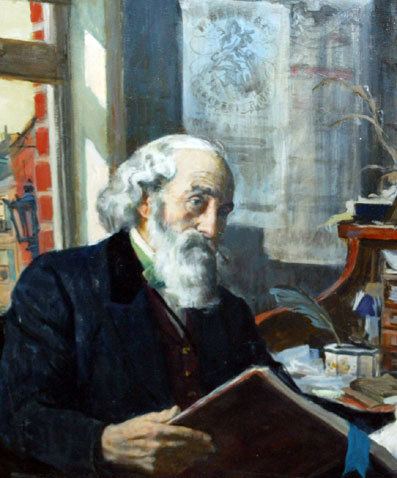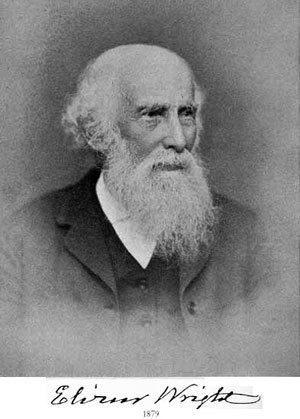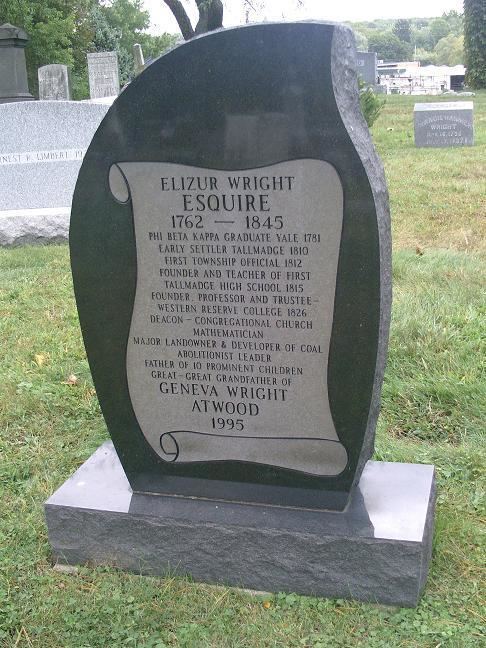Name Elizur Wright | Education Yale University | |
 | ||
Books Valuation Tables, on the Combined Experience, | ||
Elizur Wright (12 February 1804 – 22 November 1885) was an American mathematician and abolitionist. He is sometimes described as the "father of life insurance" in the United States. He is also sometimes called the "father of insurance regulation", as he campaigned that life insurance companies must keep reserves, provide surrender values, and served as an insurance commissioner for the State of Massachusetts.
Contents

Early life

Wright was born in South Canaan, Connecticut, as part of a devout Christian family who held anti-slavery beliefs and instilled in him a strict moral character. His father, also named Elizur (1762-1845), graduated at Yale in 1781, and was known for his mathematical learning and devotion to the Calvinist faith. In 1810 the family moved to Tallmadge, Ohio, and the younger Elizur worked on the farm and attended an academy that was conducted by his father. The famous abolitionist John Brown attended the Academy in Tallmadge with Elizur. His home was often the refuge for fugitive slaves.

In 1826, the younger Wright graduated from Yale and began to teach: first for two years in Groton, Massachusetts, then at Hudson, Ohio, as a mathematics and natural philosophy professor at Western Reserve College (1829-1833), now Case Western Reserve University. It was during this time that Wright first encountered the writings of William Lloyd Garrison. Garrison's pamphlet, "Thoughts on African Colonization," persuaded Wright to believe that slavery should immediately be abolished, and that the American Colonization Society's effort to deport free blacks to an African colony was immoral and ineffective.
Abolitionist

Along with Lewis Tappan, Arthur Tappan, Theodore Weld, James Birney, and other like-minded individuals, Wright founded the American Anti-Slavery Society at a convention in Philadelphia in December 1833, the year Wright had moved to New York City. Wright became the national secretary of the organization for five years. At this time, the American Anti-Slavery Society espoused the immediate abolition of slavery, called for an end to all racial prejudice and equality for all. To effect this change, members practiced a policy of "moral suasion," an appeal to people's ethics in an attempt to get them to embrace abolitionism and renounce slavery as sinful.

Wright edited a large number of publications, including Human Rights (1834-1835), The Emancipator and the Quarterly Anti-Slavery Magazine (1835-1838). His continued opposition to slavery incurred the enmity of its advocates, and his house was once besieged by a mob, and an attempt was made to kidnap him and convey him to North Carolina. In 1838, he moved to Boston, where he became editor of the Massachusetts Abolitionist in April 1839. In 1846 he established the Chronotype newspaper, which he conducted until it was absorbed by the Commonwealth (1850), of which also he was for a time the editor.

He was also involved in "The Great Postal Campaign" – a project whose job was to distribute abolitionist material across the country. The Anti-Slavery Society was successful in recruiting agents throughout the country to spread their message, but when Garrison and others began to broaden the scope of the Society to include women's rights and took on an anti-religion, anti-government tone, Wright and others objected and began to split from the Society in 1840.
Wright became involved with the newly created Liberty Party and began to separate from the evangelists and the religious anti-slavery movements, believing that government intervention was the way to abolition. Wright was a member of the Boston Vigilance Committee, an organization that assisted fugitive slaves. He was arrested and charged for aiding in the 1851 escape of Shadrach Minkins, the first black man to be seized in New England under the Fugitive Slave Act. He was not convicted. Wright was also indicted and tried for libel in consequence of his severe words for the liquor interests while publishing the Chronotype.
Wright eventually became estranged from the abolitionist movement. Moreover, due partially to disappointment in his church's lack of support for the abolitionist cause, and to a slowly growing desire to find secular solutions to social problems, the formerly pious and devout Congregationalist. Eventually, Wright became an atheist.
Business
Between 1853 and 1858, besides editing the Railroad Times, he gave his attention to invention and mechanics, constructing a spike-making machine, a water faucet, and an improvement in pipe coupling. He patented the last two, and manufactured them for a short time.
According to Frank Preston Stearns, Wright became interested in life insurance as a mathematical study and read "the best works on life insurance ... with the same ardor with which young ladies devour an exciting novel."
In the spring of 1852 an insurance broker placed an advertising booklet in his hand wherein Elizur Wright looked it over and perceived quickly enough that no company could undertake to do what this one pretended to and remain solvent. At age 40, Wright visited the Royal Exchange in London to investigate the life insurance industry. It was on this trip where he saw an advertisement in the Daily Telegraph for the Sale of 42 Old Life Insurance Policies in which old men were auctioning off their life insurance policies to investors after faithfully paying premiums all their lives. Elizur recognized that these life insurance policy owners were too old to work and could no longer afford their premium payments but were not yet dead to collect the benefit. As a result the policy owners looked to speculators or investors. Wright recognized and wrote about the fact that life insurance policy owners were not able to obtain as much as half of the value that should be in these policies, but do obtain such from investors in his book Politics and Mysteries of Life Insurance.
To Wright, this was unconscionable, and upon his return to America, he began campaigning for a cleanup of the life insurance business, by requiring insurers to pay “surrender values” to policyholders on request and to hold adequate reserves to do so. Wright realized how easy it was to for insurance carriers to cheat, so he devised formulas for calculating the reserves and created statutory capital requirements for the industry. Ultimately, the life insurance industry accepted Wright's reforms. Wright served as an insurance commissioner for the State of Massachusetts from 1858 to 1866.
He devised a new formula for finding the values of policies of various terms, known as the “accumulation formula,” and, in order to facilitate his work, invented and afterward patented (1869) the “arithmeter,” a mechanical contrivance for multiplication and division, based on the logarithmic principle, a form of cylindrical slide rule.
Public parks
Wright, a member of the Forestry Association, was instrumental in obtaining the Massachusetts Forestry Act of 1882. He initiated and promoted plans for making Middlesex Fells, an area north of Boston bordering Malden and Melrose, into a public park; although he did not succeed during his lifetime, the plan was carried out later and Middlesex Fells is Middlesex Fells Reservation to this day.
Other activities
Wright served as an officer of the National Liberal League.
Along with his rationalist approach to insurance and religion, Wright was an ardent advocate of a phonetic writing system he called "phonotypy." A column written in this system appeared in almost every issue of his newspaper, the Chronotype (1846-1850).
Writings
In addition, he wrote many pamphlets and reports.
